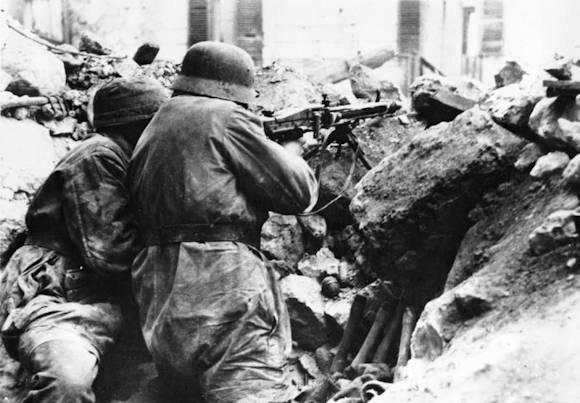The Italian political events between the 25 July and the 8 September 1943 clearly could not reverberate all their gravity on the already extremely precarious German defense device of continental Italy. Since the replacement of Mussolini with Marshal Badoglio, the OKW reaction to this new Italian crisis was immediately ready: the 27 July Leader in person he ordered Rommel (who was then settling in Greece) to immediately take command for the defense of northern Italy under the command ofHeeresgruppe B (group of armies B); doing so, however, (albeit briefly until the destination of the desert fox to the role of inspector of the fortifications of the Atlantic Wall on the French Atlantic coast) the German chain of command was complicated, despite the fact that now Kesselring (still nominally superior to Rommel as chief commander, Oberbefehlshaber) could, at the head of Heeresgruppe C, focus on the defense of southern Italy, south of Rome. Meanwhile, Student could also move from the south of France 2 ^ fallschirmjäger division in the area of Ostia, without even informing the Italian High Command of its arrival; under the command of the general German paratrooper was also placed the 3 ^ panzergranadieren division who came from Orvieto, with the explicit task of keeping himself in a state of alert in order to be able immediately to face a general Italian military defection by promptly disarming all the troops of the former ally around Rome. After the war the testimony of the Chief of Staff of Kesselring, General Sigfried Westphal was able to describe with great detail the reactions of the German Field Marshal in the days immediately preceding the armistice. The objective (defined since the beginning of August) was to attack and capture the Italian aviation formations only in the places closest to German force concentrations; a Kriegsmarine would have been the task (in fact impossible) to prevent the escape of the Italian surface fleet using the latest submarines and torpedo boats available in Italian ports, while the newly established 10 ^ armed (under Von Vietinghoff) was given the opportunity to reach agreements with the Italian armed forces in southern Italy to disarm them without committing hostile acts: for no reason did the German armed forces open fire first.
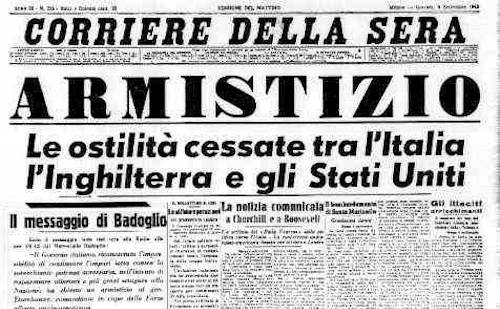 In a climate of increasing tension, this was how the 8 September arrived: Kesselring and Westphal learned of the armistice with the allies during a meeting in the Italian Supreme Command at Monterotondo with General Mario Roatta; the news sent to the German officers by a phone call from Colonel Von Waldenburg, the Italian general followed reassurance on the continuation of the common struggle despite the English propaganda maneuvers ... In the area of Rome Student decided to immediately go to the streets by moving the paratroopers against his former allies: at least 30 general and 150 senior officers of various Italian commands were captured, but the Chief of Staff Ambrosio, King Vittorio Emanuele and Prince Umberto had managed to get away from Rome the night before. The situation around the capital, despite Roatta's orders to General Carboni to resist mainly in the road axes around Tivoli, came to be resolved favorably to the Germans with the full acceptance of the German offer of surrender, a circumstance that definitively eliminated a logistical threat behind the 10 ^ armed. Now for Kesselring the real challenge was opened against the Allied armies in advance: the realism of the German Field Marshal was once again lucid and impeccable; as far as the Allied landing was to the south, the German hopes of seriously opposing Clark and Montgomery would have been weak; a joint Italian-allied attack in the area of Rome would have automatically cut out the whole 10 ^ armed, forcing the Reich to abandon any defensive ambitions even only tactics of the whole southern Italy.
In a climate of increasing tension, this was how the 8 September arrived: Kesselring and Westphal learned of the armistice with the allies during a meeting in the Italian Supreme Command at Monterotondo with General Mario Roatta; the news sent to the German officers by a phone call from Colonel Von Waldenburg, the Italian general followed reassurance on the continuation of the common struggle despite the English propaganda maneuvers ... In the area of Rome Student decided to immediately go to the streets by moving the paratroopers against his former allies: at least 30 general and 150 senior officers of various Italian commands were captured, but the Chief of Staff Ambrosio, King Vittorio Emanuele and Prince Umberto had managed to get away from Rome the night before. The situation around the capital, despite Roatta's orders to General Carboni to resist mainly in the road axes around Tivoli, came to be resolved favorably to the Germans with the full acceptance of the German offer of surrender, a circumstance that definitively eliminated a logistical threat behind the 10 ^ armed. Now for Kesselring the real challenge was opened against the Allied armies in advance: the realism of the German Field Marshal was once again lucid and impeccable; as far as the Allied landing was to the south, the German hopes of seriously opposing Clark and Montgomery would have been weak; a joint Italian-allied attack in the area of Rome would have automatically cut out the whole 10 ^ armed, forcing the Reich to abandon any defensive ambitions even only tactics of the whole southern Italy.
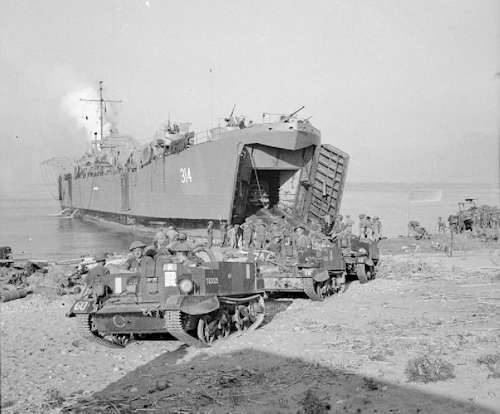 In the end the main American landing with the 5 ^ armed took place in Salerno the 9 September, with the operation Avalanche, while on the same day the 8 ^ British Army (with the operation Slapstick) was launched to conquer Puglia and the Adriatic backbone of the peninsula, after the 3 had landed in Calabria without meeting major resistance: Churchill in person always attributed great importance to the Balkan war chessboard and the conquest of port infrastructures and aerodromes of the area Taranto and Foggia allowed the allied air forces to finally launch an air campaign of logistic support to the titanic forces in Yugoslavia, a strategic attack against Austria and Bavaria and especially a last against the oil wells of Ploiesti, in Romania , contributing decisively to depriving the German armed forces of fuel reserves for long-range operations even before the opening of the second front in Normandy; no less important was the opening of the Mediterranean convoys to Russia, which at this point with the exit of the Italian navy, the now peaceful compliant neutrality of Turkey and the total inadequacy of the Luftwaffe forces in the Aegean could have enjoyed of strategic availability of materials and food by limiting the Arctic routes from Iceland, which have always been extremely dangerous due to the joint presence of the U-Boot and the German air coverage from Norway. At that time Kesselring had only a few divisions of the armed 10 ^ to cope with this double threat, given that the bulk of the German forces were still north of Rome under Rommel's command to disarm the Italian army, but nevertheless the defense German was so ferocious that American landings were about to fail for weeks; it was the energetic test of the men of Von Vietinghoff that gave Hitler the hope of being able to strategically defend the territory of the former ally, rejecting Rommel's hypothesis for a retreat almost to the pre-Alpine areas of the country. The desert fox, starting its slow but inevitable loss of prestige at the Leader, at this point it was sent to Normandy to oversee the German construction of defense of the Atlantic Wall, Kesselring remained at this point the only summit of the German chain of command for the Italian campaign.
In the end the main American landing with the 5 ^ armed took place in Salerno the 9 September, with the operation Avalanche, while on the same day the 8 ^ British Army (with the operation Slapstick) was launched to conquer Puglia and the Adriatic backbone of the peninsula, after the 3 had landed in Calabria without meeting major resistance: Churchill in person always attributed great importance to the Balkan war chessboard and the conquest of port infrastructures and aerodromes of the area Taranto and Foggia allowed the allied air forces to finally launch an air campaign of logistic support to the titanic forces in Yugoslavia, a strategic attack against Austria and Bavaria and especially a last against the oil wells of Ploiesti, in Romania , contributing decisively to depriving the German armed forces of fuel reserves for long-range operations even before the opening of the second front in Normandy; no less important was the opening of the Mediterranean convoys to Russia, which at this point with the exit of the Italian navy, the now peaceful compliant neutrality of Turkey and the total inadequacy of the Luftwaffe forces in the Aegean could have enjoyed of strategic availability of materials and food by limiting the Arctic routes from Iceland, which have always been extremely dangerous due to the joint presence of the U-Boot and the German air coverage from Norway. At that time Kesselring had only a few divisions of the armed 10 ^ to cope with this double threat, given that the bulk of the German forces were still north of Rome under Rommel's command to disarm the Italian army, but nevertheless the defense German was so ferocious that American landings were about to fail for weeks; it was the energetic test of the men of Von Vietinghoff that gave Hitler the hope of being able to strategically defend the territory of the former ally, rejecting Rommel's hypothesis for a retreat almost to the pre-Alpine areas of the country. The desert fox, starting its slow but inevitable loss of prestige at the Leader, at this point it was sent to Normandy to oversee the German construction of defense of the Atlantic Wall, Kesselring remained at this point the only summit of the German chain of command for the Italian campaign.
While the 5 ^ American Army proceeded cautiously towards the north (Naples took the 6 October) and Senger completed the general retreat (mostly by air) from Corsica and Sardinia, saving actual German 30000s (this allowed the 90 ^ panzergranadieren division to reorganize itself in Pisa), the British armed 8 ^ went up the east coast with slow and strenuous progress for the tenacious German defense of natural obstacles and (on the basis of the experience of the Russian front) especially of waterways. Montgomery was in front of the natural defensive system represented by Biferno, Trigno and Sangro while to the west Clark had to overcome the Volturno and Garigliano (which almost joined the mouth of the Sangro forming an ideal bottleneck of the peninsula in its most tight and easily defensible). Kesselring decided to make his main defensive line here: the Gustav line. Equipped with anti-tank obstacles, minefields and reinforced concrete works, he could also enjoy the support of some minor defensive lines used by the German marshal to slow down the Allied advance by giving time to German troops to entrench themselves in view of the winter fighting; in the first half of January of the 1944 the American troops had reached the Garigliano, while the French colonial troops of General Juin took contact in the mountains north of Cassino with the first defenses of the real Gustav line.
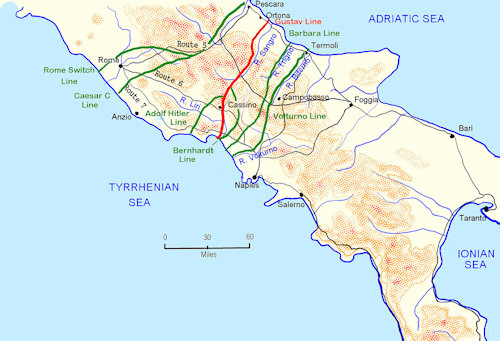 For the German command it was clear that the main allied offensive would be to the Tyrrhenian sector of the deployment, that one held by Clark with the American 5 ^ armata (including the II New Zealand corps of General Freyberg and the French expeditionary corps) Juin): the Adriatic sector held by the 8 ^ army of Montgomery (later replaced by Leese at the time of having to face the preparation of Overlord) was in fact presented as absolutely unsuitable for operations of war by movement because of the numerous waterways (thickened by a particularly rainy winter) and for easily defensible coastal mountain ranges. The attack to free Rome would have come from the west, and could also count on the use of the Via Appia (between the sea and the Aurunci mountains) and the Casilina (which crossed the Liri valley); this hypothesis was definitively confirmed (allowing Kesselring to concentrate its strategic reserves and the best static defenses there) in the light of the Montgomery general attack conducted at the end of November 1943 with modest results: it managed to advance about 22 km in a month , but its vanguard (the 1 ^ Canadian division of General Vokes) was finally finally blocked in Ortona by the increase in German resistance and the worsening of atmospheric conditions. To face Clark in the imminent battle would be the 10 ^ German army of the generaloberst Von Vietinghoff, divided into three army corps of which only two in defense of the western Tyrrhenian sector (the LXXVI corps Panzer of the general Traugott Herr would have kept the deployment in the Adriatic area): the XIV of Von Senger and the mountain body of General Valin Feurstein; in the meantime in the north of Rome the 14 ^ army of General Von Mackensen remained concentrated, in perennial alert about the possibility of an allied landing in northern Italy. The actual battle ended up turning on around the third week of January 1944 and under the most serious auspices for the allies: the 20 January the direct attempt of Clark to break through the Liri valley crossing the Rapido river in the central sector of 5 ^ beloved with a frontal attack of the 36 ^ division Texas (commanded by General Fred Walker) near the town of Sant'Angelo ended with a disaster (the 141 ^ and the 143 ^ infantry regiment suffered tremendous losses without being able to establish a bridgehead over the river) and especially the 22 January had begun the controversial disembarkation operation by the VI US Army Corps of General Lucas on the beaches of Anzio, south of Rome, but behind Gustav; demonstrating once again its full value, Kesselring managed to coordinate with Mackensen a quick and violent counterattack that forced Lucas on the defensive. Every effort to break through or bypass the line prepared by the German Marshal had failed; the only viable solution was the battle of attrition on the mountains south of Rome and the Wehrmacht would be ready.
For the German command it was clear that the main allied offensive would be to the Tyrrhenian sector of the deployment, that one held by Clark with the American 5 ^ armata (including the II New Zealand corps of General Freyberg and the French expeditionary corps) Juin): the Adriatic sector held by the 8 ^ army of Montgomery (later replaced by Leese at the time of having to face the preparation of Overlord) was in fact presented as absolutely unsuitable for operations of war by movement because of the numerous waterways (thickened by a particularly rainy winter) and for easily defensible coastal mountain ranges. The attack to free Rome would have come from the west, and could also count on the use of the Via Appia (between the sea and the Aurunci mountains) and the Casilina (which crossed the Liri valley); this hypothesis was definitively confirmed (allowing Kesselring to concentrate its strategic reserves and the best static defenses there) in the light of the Montgomery general attack conducted at the end of November 1943 with modest results: it managed to advance about 22 km in a month , but its vanguard (the 1 ^ Canadian division of General Vokes) was finally finally blocked in Ortona by the increase in German resistance and the worsening of atmospheric conditions. To face Clark in the imminent battle would be the 10 ^ German army of the generaloberst Von Vietinghoff, divided into three army corps of which only two in defense of the western Tyrrhenian sector (the LXXVI corps Panzer of the general Traugott Herr would have kept the deployment in the Adriatic area): the XIV of Von Senger and the mountain body of General Valin Feurstein; in the meantime in the north of Rome the 14 ^ army of General Von Mackensen remained concentrated, in perennial alert about the possibility of an allied landing in northern Italy. The actual battle ended up turning on around the third week of January 1944 and under the most serious auspices for the allies: the 20 January the direct attempt of Clark to break through the Liri valley crossing the Rapido river in the central sector of 5 ^ beloved with a frontal attack of the 36 ^ division Texas (commanded by General Fred Walker) near the town of Sant'Angelo ended with a disaster (the 141 ^ and the 143 ^ infantry regiment suffered tremendous losses without being able to establish a bridgehead over the river) and especially the 22 January had begun the controversial disembarkation operation by the VI US Army Corps of General Lucas on the beaches of Anzio, south of Rome, but behind Gustav; demonstrating once again its full value, Kesselring managed to coordinate with Mackensen a quick and violent counterattack that forced Lucas on the defensive. Every effort to break through or bypass the line prepared by the German Marshal had failed; the only viable solution was the battle of attrition on the mountains south of Rome and the Wehrmacht would be ready.
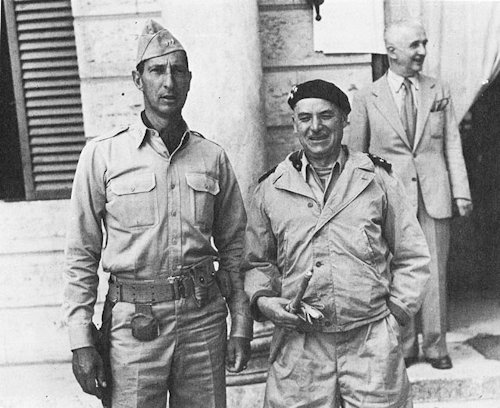 The January 24 the French and the II body of the 5 ^ armed renewed their offensive efforts, starting what was to be known as the first battle of Cassino; immediately Juin (in the picture together with Gen. Clark) wanted to reach Monte Cifalco, but the 5 ^ Gebirgs division General Ringel immediately categorically barred the step to the goumier, without the intervention of the 3 ^ Algerian infantry division (General Goislard de Monsabert), meanwhile unhooked on the left of the deployment, could circumvent the German positions; Clark was absolutely opposed in the circumstance to just trying to exploit the French breach attempt by sending reinforcements. Meanwhile downstream, with the 36 ^ of infantry still pinned in front of the Rapido, it touched the American 34 ^ division (general Charles W. Ryder) launch an attack on the hills north of Cassino to try to bypass the German defenses; Senger decided to use all the artillery available in countering the French forces but the 44 ^ Infanterie Division (general Franz Bayer) was in any case able to counteract the Americans launched at the same time as the Algerians of Monsabert further north. Immediately the American 34 ^ Red Bull (the assault was launched by its 133 ^ regiment, after 30 scant minutes of artillery support) stumbled into real rivers of mud, due to the flooding of the land (already swampy in itself ) by the Germans, who forced the American GIs to a complicated nocturnal advance in the middle of reticulates and mines; in the morning the old abandoned Italian barracks of Monte Villa were reached, but at that point the Germans spilled on the American infantry a rain of fire with machine guns and above all mortars that directly reported the 133 ^ infantry to their lines the night before. Conscious of the losses Ryder continued to insist, throwing into the 27 January the 135 ^ and the 168 ^ infantry, the remaining two regiments of the division; the attack of 168 ^ frontally invested the 131 ^ regiment grenadiers of Bayer that this time failed to hold the position, allowing the Americans in the 48 hours later to reach quota 53 and 213, the inhabited center of Cairo would have been finally taken the 31 January . The German defenders continued to keep stubbornly the ruins of the Italian barracks, but always with greater clarity a salient American was emerging behind them, directly on the heights above Cassino; in the meantime it touched the only regiment of the 36 ^ Texas Division not yet employed (the 142 ^ infantry) to attack on the right of the Allied line and join the North Africans of Juin after the conquest of Mount Manna and finally the joint efforts of 133 ^ and 168 ^ Americans were able to force the exhausted grenadiers of Bayer to fall back from the barracks towards the center of Cassino. The Americans threw themselves confidently in pursuit only to find out, however, that the town would also be defended strenuously by the Germans, who thus escaped the threat of circumvention by fighting house to house. Meanwhile, the Texas 142 ^ continued to attack on the mountains hitting southward: now Senger was really worried that the American 34 ^, reinforced by Walker's still cool regiment could really disrupt the German defense by turning an advance into a breakthrough; the only solution was to move the 90 ^ Panzergrenadier of the generalmajor Ernst Günther Baade from the sector before the British body X (between the sea and the locality of Sant 'Ambrogio) to oppose the infantrymen of Ryder, trusting that Clark should have (and wanted) to address the tactical weight of the battle now only in the mountains around Cassino.
The January 24 the French and the II body of the 5 ^ armed renewed their offensive efforts, starting what was to be known as the first battle of Cassino; immediately Juin (in the picture together with Gen. Clark) wanted to reach Monte Cifalco, but the 5 ^ Gebirgs division General Ringel immediately categorically barred the step to the goumier, without the intervention of the 3 ^ Algerian infantry division (General Goislard de Monsabert), meanwhile unhooked on the left of the deployment, could circumvent the German positions; Clark was absolutely opposed in the circumstance to just trying to exploit the French breach attempt by sending reinforcements. Meanwhile downstream, with the 36 ^ of infantry still pinned in front of the Rapido, it touched the American 34 ^ division (general Charles W. Ryder) launch an attack on the hills north of Cassino to try to bypass the German defenses; Senger decided to use all the artillery available in countering the French forces but the 44 ^ Infanterie Division (general Franz Bayer) was in any case able to counteract the Americans launched at the same time as the Algerians of Monsabert further north. Immediately the American 34 ^ Red Bull (the assault was launched by its 133 ^ regiment, after 30 scant minutes of artillery support) stumbled into real rivers of mud, due to the flooding of the land (already swampy in itself ) by the Germans, who forced the American GIs to a complicated nocturnal advance in the middle of reticulates and mines; in the morning the old abandoned Italian barracks of Monte Villa were reached, but at that point the Germans spilled on the American infantry a rain of fire with machine guns and above all mortars that directly reported the 133 ^ infantry to their lines the night before. Conscious of the losses Ryder continued to insist, throwing into the 27 January the 135 ^ and the 168 ^ infantry, the remaining two regiments of the division; the attack of 168 ^ frontally invested the 131 ^ regiment grenadiers of Bayer that this time failed to hold the position, allowing the Americans in the 48 hours later to reach quota 53 and 213, the inhabited center of Cairo would have been finally taken the 31 January . The German defenders continued to keep stubbornly the ruins of the Italian barracks, but always with greater clarity a salient American was emerging behind them, directly on the heights above Cassino; in the meantime it touched the only regiment of the 36 ^ Texas Division not yet employed (the 142 ^ infantry) to attack on the right of the Allied line and join the North Africans of Juin after the conquest of Mount Manna and finally the joint efforts of 133 ^ and 168 ^ Americans were able to force the exhausted grenadiers of Bayer to fall back from the barracks towards the center of Cassino. The Americans threw themselves confidently in pursuit only to find out, however, that the town would also be defended strenuously by the Germans, who thus escaped the threat of circumvention by fighting house to house. Meanwhile, the Texas 142 ^ continued to attack on the mountains hitting southward: now Senger was really worried that the American 34 ^, reinforced by Walker's still cool regiment could really disrupt the German defense by turning an advance into a breakthrough; the only solution was to move the 90 ^ Panzergrenadier of the generalmajor Ernst Günther Baade from the sector before the British body X (between the sea and the locality of Sant 'Ambrogio) to oppose the infantrymen of Ryder, trusting that Clark should have (and wanted) to address the tactical weight of the battle now only in the mountains around Cassino.
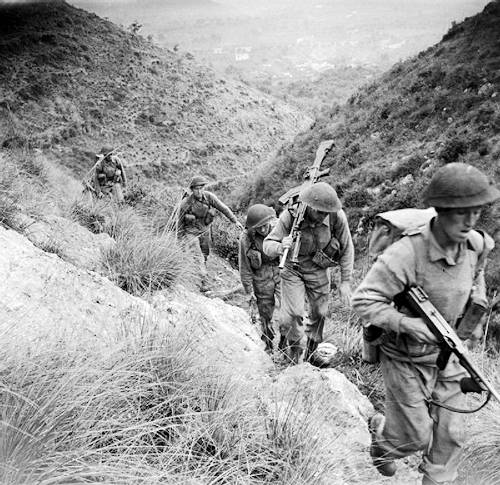
US attacks on the mountains around Cassino dragged themselves wearily until early February, with modest progress on the spurs of Sneakeshead and Phantom Ridge; after a short pause then, the 7 February Clark tried the decisive assault towards the valley of Liri launching to attack the 36 ^ and the 34 ^ to complete: the X body of British McCreery would have leaned to south, while to north the North Africans Juin would have attacked too. Inside Cassino the 133 ^ was driven out of the city towards the valley floor, while other regiments gave their energies to take the high posts that were perennially delineated in the hills behind the village; the hardest fights occurred at Monte Castellone and on Mount Maiola where some German positions actually gave way but only to be taken by the previous occupants a little later. In the end, tired and discouraged the Americans had to fall back to the starting positions, renouncing the breakthrough just as the inclement weather conditions gave great help to the German defense still heavily entrenched on a rugged and defensible terrain; the outcome of the first battle of Cassino was clear and simple: German tactical victory and sadly stopped front in front of Gustav.
Meanwhile on the Lazio coast the epic of the VI body of Lucas was consummated. 96 hours had passed by the landing but the American commander still did not advance; the caution and the method of the subject of Clark had allowed the Germans to block the passage to the Alban Hills, but above all they had immediately made Kesselring aware of the primary objective of the American landing with consequent advance in the hinterland: to arrive at Valmontone and Cisterna to sever the logistical connections with the rearguard and all northern Italy represented by Casilina and Appia. After days of inconclusive clashes on the perimeter of the bridgehead, finally the 30 January the Americans tried to take the initiative to push Mackensen's men back by launching the general attack, just as the Wehrmacht commander also gave the order to throw Americans back into the sea; the attack started with the 45 ^ American division, supported by compatriots of the 3 ^, by the British 1 ^ of the major general William Penney and by the groups of tanks of the US armored 1 ^ (general Ernest Harmon), on the left the British advanced by a couple of miles to the Alban hills before being blocked by the organized German resistance, while on the right the rangers of Colonel William O'Darby launched a disastrous attack against Cisterna against Hermann Göring that led to the annihilation of two battalions out of three available of the attackers, all while also the 3 ^ was easily stopped. Now Mackensen after just 48 hours of allied initiative was ready to launch in the battle Tigre to go to the counterattack, the first to really realize the gravity of the situation was General Lucian Truscott, commander of the 3 ^ infantry: the Germans in addition to not backward were becoming every hour more numerous in every sector of the battlefield; the order to get on the defensive was peremptory and Lucas himself had nothing to object: the Americans were about to suffer on their own skin the harsh experience acquired by the German body commanders on the Eastern front in terms of counterattacks launched by armored Kampfgruppe.
by Manuele Serventi Merlo and Federico Massa
(photo: web)

